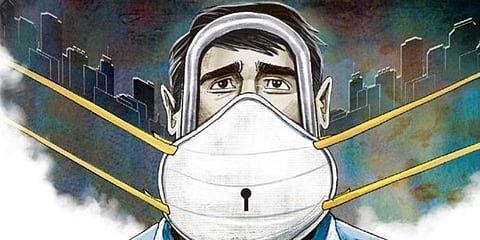Except Delhi, lockdown didn’t give quick results
NEW DELHI: An analysis of the partial or full lockdowns imposed to combat the Covid second wave by various states since last month shows that apart from Delhi, most states have not seen a progressive reduction of fresh cases in the initial weeks despite the curbs.
The graph began tapering only after May 9. For instance, while Maharashtra had around 60,000 daily new cases from April 15 to 26, which dropped to 48,700 on April 27, the count subsequently climbed to the 55,000-60,000 range.
It’s only after May 9 that there has been a progressive reduction of cases. Maharashtra health minister Rajesh Tope said the lockdown helped bring down positive cases from the peak of 69,000 per day to below 40,000.
“People should follow the lockdown restrictions strictly because it helps break the virus chain and reduce the burden on hospitals. However, in a rural area, positive cases are still rising. Self-discipline is very important to defeat the virus,” he said.
Tope added that the state needed more restrictions to contain the virus. He was hopeful that by the end of May, the situation in Maharashtra will be much better.
The positivity rate in the state also witnessed a decline from around 26% on April 15 to 16% on May 14. Dr D C S Reddy, former head of the department at the Institute of Medical Sciences at Banaras Hindu University, said to accurately analyse the data, a seven-day moving average is a better parameter as the number of cases tested and confirmed on a daily basis depends on various other factors and hence there are fluctuations in numbers.
“In terms of lockdown, it was taken to ensure that transmission is slowed down both intra-state and interstate. Also, to get a better picture of the decline, we need to wait a little longer. The rate of decline is slow in the initial phases but speeds up with time. So, we will get a clearer picture in the coming weeks,” he said.
Delhi, on the other hand, saw a progressive decline in the case count and the positivity rate. While the number of cases hovered in the 20,000- 25,000 range till May 2, it fell to just over 8,500 on May 14.
Fall in cases not as steep in states where partial or phased lockdown imposed
Positivity rates also took a sharp dive from 16% on April 19 to 12.2% on May 14. In Haryana, the number of cases since the imposition of the lockdown on May 2 has been hovering around 13,000- 15,000 per day with the state recording its lowest per day tally since the imposition of the restrictions on May 14 with just over 10,600 cases. The positivity rate also saw a dip from around 26.5% to 16%.
Amit Arya, media adviser to Haryana Chief Minister M L Khattar, said: “After the lockdown was imposed, cases have come down. From 16,000 cases a day, the number is around 10,000 now. Also there is more availability of beds as more Covid care centres have been set up and a few more will be inaugurated by Chief Minister Khattar on Sunday. Besides, the availability of oxygen in the state is much better,” he said.
In states like Madhya Pradesh and Punjab, where the lockdown was partial or phased, the fall in the number of cases has not been as steep.
For instance, MP recorded just under 5,000 cases on April 9, when lockdown was imposed in some parts. The tally gradually grew to around 23,000 on May 9, after which there has been a steady drop with the state witnessing just over 15,600 cases on May 14.
The positivity rate has seen a drop from almost 25% on April 20 to just under 12% on May 14. West Bengal, which saw an eight-phase state elections, imposed partial restrictions on April 30. Its per day cases have been on the rise since then from around 17,000 a day on April 30 to over 20,000 on May 14.
However, the positivity rate has seen a slight dip from over 32% on April 30 to just under 30% on May 14. Similar trends were noticed in states like Punjab, Uttar Pradesh and Odisha, which imposed partial lockdowns on April 27, April 24 and May 5, respectively.
Despite the drop in the number of cases and positivity rates in the states, the number of deaths have been on the rise in almost all the states since the complete or partial lockdowns kicked in. Delhi’s deaths peaked on May 3 (448) while on May 14, the day’s toll was 289. Maharashtra’s worst day in terms of deaths was April 28 (1,035) after which the number fluctuated.

